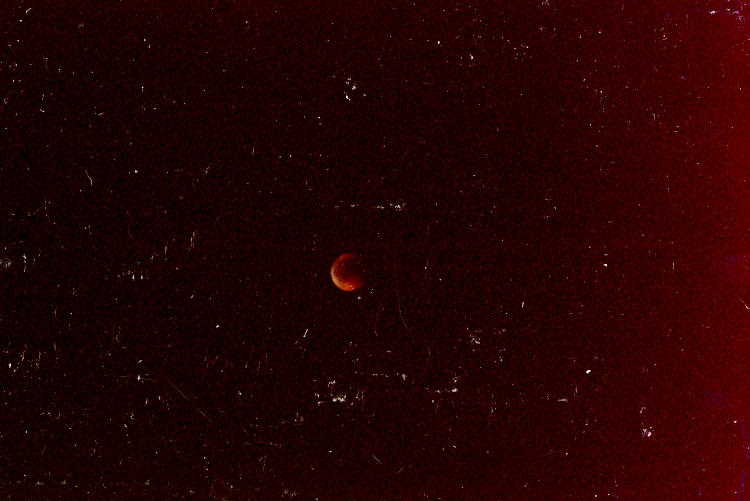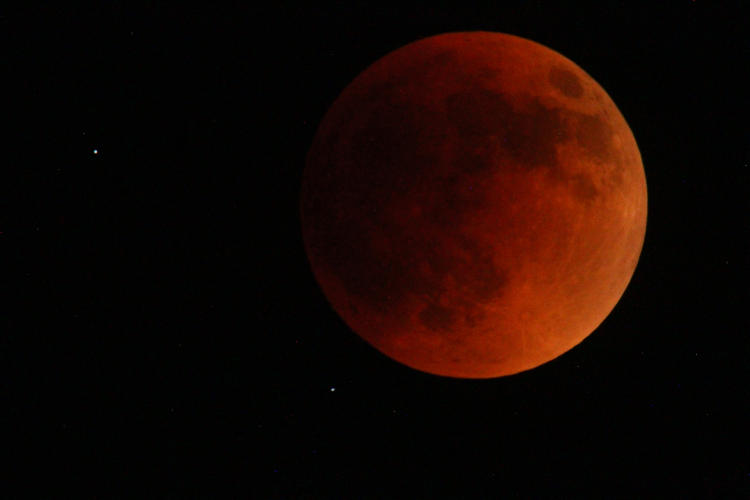Sometimes – sometimes – it all comes together nicely. I can appreciate it the few times that it does.

First off, this looks so crappy because I didn’t feel the need to try and clean it up, mostly. Some of it is due to age, however, and the general shortevity (that’s a word, honest) of print film/negatives. But this is the first total lunar eclipse that I’d photographed, and dates from August 16th, 1989 – technically, it may be the 17th, since it appears this might be right at the end of totality sometime after midnight (Stellarium is wonderful.) Since I only had the Witnnauer Challenger with its 50mm lens then, I borrowed a Pentax K1000 with some unremembered zoom telephoto – this image was likely taken at either 210 or 260mm focal length, just from knowing the options available at the time. It was film of course, so no display of the results afterwards, and thus only a guess at exposure, which the film scanner may well have tried altering, but I know motion blur was in there solely from the progression of the dim moon, and likely from the tripod as well. Later on that same night, I’d capture my first “Wow!” photo*.
You know what’s coming, don’t you?

Yes, this is from two nights ago, Sunday the 15th, so there’s just shy of 33 years in between. While skimming through negatives a bit over a week ago, I came across the top frame, part of a sequence, and knew the eclipse was coming up this month, so I figured I had my ‘Visibly Different’ example for the week, provided it all panned out – the weather reports were not too reassuring on that account, and even the preliminary frames at moonrise didn’t make me feel comfortable. The clouds were scattered but actually obscuring the moon right at the start of the umbral phase, so I missed the initial darkening of the ‘limb,’ but they cleared for the run towards totality.
The changes between the two frames? There are almost too many to count. The lens of course: the latter was shot with the Tamron 150-600 at 600mm, but with a 2x converter, so closer to 1000mm, but with the multiplier that’s more like 1600 (both of these images are full-frame, by the way.) Changing ISO on the fly meant I could switch to 6400 rather than being stuck with Kodak Gold 400-2 like the top pic, and I could chimp at the exposures to ensure that I was getting decent results – I could even chimp at the initial frames, as the partial eclipse progressed, to ensure focus was as tight as possible. A solid tripod, set low to the ground for stability, a cable release, and mirror lock-up, all to eliminate as much vibration as possible**. A lot of this comes courtesy of previous experience too, having already suffered the shortcomings of certain practices.
There will be more coming along shortly, but I wanted to get the weekly topic taken care of first.
* If you went to that link and read the description, you might have noticed the line, “over a decade ago,” which I find amusing since it’s over three decades ago now. But that page was first written in the early 2000s, and I wasn’t recalling the date of the eclipse, so I played it safe. I could correct it now of course, but it still remains accurate, if a little misleading. It’s a reminder of how long I’ve had this website, though.
** Just the normal operations of an SLR camera, digital or not, induces vibrations, and these can be visible at high magnifications or long exposures. The worst is mirror slap, as the reflex mirror flips up out of the way to allow the light from the lens to reach the focal plane, where the sensor (or the film) resides. Mirror lock-up is an option on most decent SLR cameras – I even had it on the Canon Elan IIe – which flips the mirror up well before the shutter opens, to allow time for the vibrations to die down. With the 7D, this is manually timed: one press of the shutter release flips up the mirror, and the second trips the shutter, so the delay is up to you, and I was using around five seconds for most of the frames the other night. When you’re looking through the viewfinder and you can see how long the vibrations last from just nudging the camera, you’re convinced of the value of this option. But remember to turn it off at the end of the session ;-)




















































